Steam System Expansion
Pipe expansion and support
Any steam system must be fully supported, able to expand during operation and sufficiently flexible to allow movement as a result.
Allowance for expansion All pipes will be installed at ambient temperature. Pipes carrying hot fluids such as water or steam operate at higher temperatures. It follows that they expand, especially in length, with an increase from ambient to working temperatures. This will create stress upon certain areas within the distribution system, such as pipe joints, which, in the extreme, could fracture.
More detailed information about allowance for expansion is given at the International website of Spirax Sarco
Pipework flexibility
The pipework system must be sufficiently flexible to accommodate the movements of the components as they expand. In many cases the flexibility of the pipework system, due to the length of the pipe and number of bends and supports, means that no undue stresses are imposed. In other installations, however, it will be necessary to incorporate some means of achieving this required flexibility.
An example on a typical steam system is the discharge of condensate from a steam mains drain trap into the condensate return line that runs along the steam line (image below). Here, the difference between the expansions of the two pipework systems must be taken into account. The steam main will be operating at a higher temperature than that of the condensate main, and the two connection points will move relative to each other during system warm-up.
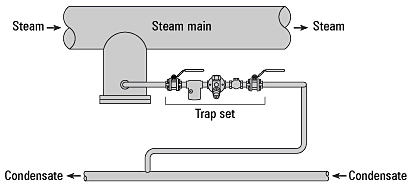
The amount of movement to be taken up by the piping and any device incorporated in it can be reduced by 'cold draw'. The total amount of expansion is first calculated for each section between fixed anchor points. The pipes are left short by half of this amount, and stretched cold by pulling up bolts at a flanged joint, so that at ambient temperature, the system is stressed in one direction. When warmed through half of the total temperature rise, the piping is unstressed. At working temperature and having fully expanded, the piping is stressed in the opposite direction. The effect is that instead of being stressed from 0 F to +1 F units of force, the piping is stressed from -1/2 F to + 1/2 F units of force.
In practical terms, the pipework is assembled cold with a spacer piece, of length equal to half the expansion, between two flanges. When the pipework is fully installed and anchored at both ends, the spacer is removed and the joint pulled up tight (image below).
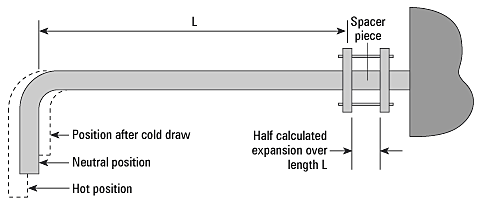
The remaining part of the expansion, if not accepted by the natural flexibility of the pipework will call for the use of an expansion fitting.
In practice, pipework expansion and support can be classified into three areas as shown in the image below.

The fixed or 'anchor' points 'A' provide a datum position from which expansion takes place.
The sliding support points 'B' allow free movement for expansion of the pipework, while keeping the pipeline in alignment.
The expansion device at point 'C' is to accommodate the expansion and contraction of the pipe.
More detailed information about allowance for expansion is given at the International website of Spirax Sarco
Expansion loops
The expansion loop can be fabricated from lengths of straight pipes and elbows welded at the joints (image below).
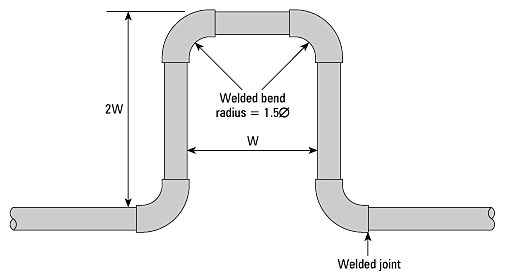
Sliding joint
These are sometimes used because they take up little room, but it is essential that the pipeline is rigidly anchored and guided in strict accordance with the manufacturers' instructions; otherwise steam pressure acting on the cross sectional area of the sleeve part of the joint tends to blow the joint apart in opposition to the forces produced by the expanding pipework (see image below). Misalignment will cause the sliding sleeve to bend, while regular maintenance of the gland packing may also be needed.
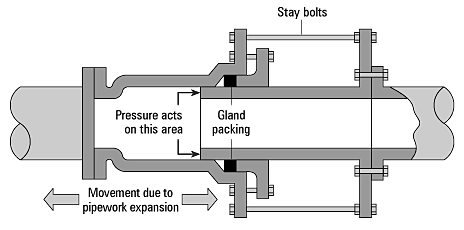
Expansion bellows
An expansion bellows, image below, has the advantage that it requires no packing (as does the sliding joint type). But it does have the same Disadvantages as the sliding joint in that pressure inside tends to extend the fitting, consequently, anchors and guides must be able to withstand this force.
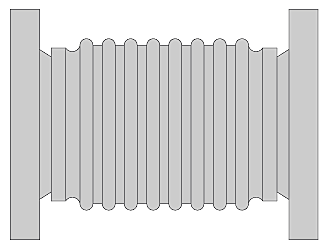
Bellows may incorporate limit rods, which limit over-compression and over-extension of the element. These may have little function under normal operating conditions, as most simple bellows assemblies are able to withstand small lateral and angular movement. However, in the event of anchor failure, they behave as tie rods and contain the pressure thrust forces, preventing damage to the unit whilst reducing the possibility of further damage to piping, equipment and personnel (image below.. Lateral and angular movement of bellows).
Where larger forces are expected, some form of additional mechanical reinforcement should be built into the device, such as hinged stay bars (image below.. Angular and axial movement of bellows).
There is invariably more than one way to accommodate the relative movement between two laterally displaced pipes depending upon the relative positions of bellows anchors and guides. In terms of preference, axial displacement is better than angular, which in turn, is better than lateral. Angular and lateral movement should be avoided wherever possible.
The image below give a rough indication of the effects of these movements, but, under all circumstances, it is highly recommended that expert advice is sought from the bellows' manufacturer regarding any installation of expansion bellows.
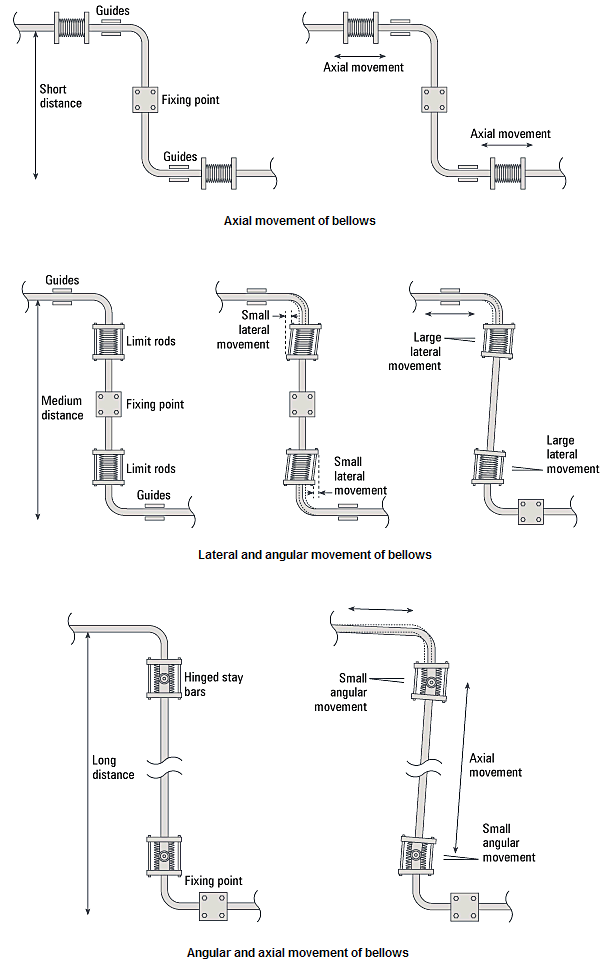
Pipe support spacing
The frequency of pipe supports will vary the bore of the pipe; the actual pipe material (i.e. steel or copper); and whether the pipe is horizontal or vertical.
Some practical points worthy of consideration are as follows..
- Pipe supports should be provided at intervals not greater than shown in the table below, and run along those parts of buildings and structures where appropriate supports may be mounted.
| Nominal pipe size (mm) | Interval of horizontal run (metre) | Interval of vertical run (metre) | |||
| Steel bore | Copper O.D. | Mild steel | Copper | Mild steel | Copper |
| 15 | 15 | 1.8 | 1.2 | 2.4 | 1.8 |
| 20 | 22 | 2.4 | 1.2 | 3.0 | 1.8 |
| 25 | 28 | 2.4 | 0.5 | 3.0 | 2.4 |
| 32 | 35 | 2.4 | 1.8 | 3.7 | 3.0 |
| 40 | 42 | 2.4 | 1.8 | 3.7 | 3.0 |
| 50 | 54 | 2.4 | 1.8 | 4.6 | 3.0 |
| 65 | 67 | 3.0 | 2.4 | 4.6 | 3.7 |
| 80 | 76 | 3.0 | 2.4 | 4.6 | 3.7 |
| 100 | 108 | 3.0 | 2.4 | 5.5 | 3.7 |
| 125 | 133 | 3.7 | 3.0 | 5.5 | 3.7 |
| 150 | 159 | 4.5 | 3.7 | 5.5 | |
| 200 | 6.0 | 8.5 | |||
| 250 | 6.5 | 9.0 | |||
| 300 | 7.0 | 10.0 | |||
- Where two or more pipes are supported on a common bracket, the spacing between the supports should be that for the smallest pipe.
- When an appreciable movement will occur, i.e. where straight pipes are greater than 15 metres in length, the supports should be of the roller type as outlined previously.
- Vertical pipes should be adequately supported at the base, to withstand the total weight of the vertical pipe and the fluid within it. Branches from vertical pipes must not be used as a means of support for the pipe, because this will place undue strain upon the tee joint.
- All pipe supports should be specifically designed to suit the outside diameter of the pipe concerned. The use of oversized pipe brackets is not good practice.
More detailed information about Pipe Expansion and Support is given at the International website of Spirax Sarco